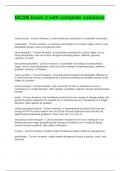H.J. Geels
Samenvatting van het gehele boek
,Inhoudsopgave
1. Technische Analyse: wat is dat? ...................................................................................................... 4
Definitie ............................................................................................................................................... 4
Charttechnische versus statistische analyse ....................................................................................... 4
Veronderstellingen .............................................................................................................................. 5
Beginselen van de Dow-theorie .......................................................................................................... 5
Een andere grote analist was Elliott. ................................................................................................... 6
2. Kritiek op de technische analyse ..................................................................................................... 7
De efficiënte-markttheorie.................................................................................................................. 7
De fundamentele analyse.................................................................................................................... 7
De random walk-theorie ..................................................................................................................... 7
Self-fulfilling prophecy ........................................................................................................................ 7
Gebruik van historische informatie ..................................................................................................... 7
De chaostheorie .................................................................................................................................. 7
3. Het begrip trend en de verschillende soorten markten nader verklaard ....................................... 9
Wat is een trend? ................................................................................................................................ 9
Andere soorten markten ..................................................................................................................... 9
Het gebruik van de juiste tool in de juiste markt .............................................................................. 10
Beleggen met de juiste tijdshorizon .................................................................................................. 12
4. Verschillende soorten grafieken ................................................................................................... 13
De lijngrafiek...................................................................................................................................... 13
De barchart ........................................................................................................................................ 13
Candlecharts ...................................................................................................................................... 13
Gaps in de grafieken .......................................................................................................................... 17
5. Trendlijnen en trendkanalen ......................................................................................................... 18
De psychologie van steun en weerstand ........................................................................................... 18
Trendlijnen en het fan-principe......................................................................................................... 18
Trandkanalen ..................................................................................................................................... 19
Fibonacci-rentracements .................................................................................................................. 19
6. Omkeerpatronen ........................................................................................................................... 20
Hoofd-en-schouderspatronen ........................................................................................................... 20
Dubbele en drievoudige toppen en bodems..................................................................................... 21
Rounding tops en rounding bottoms ................................................................................................ 22
Broadening formations...................................................................................................................... 22
, Diamantformaties ............................................................................................................................. 22
8. Inleiding tot de Elliott Wave-theorie ............................................................................................. 23
Basisprincipes .................................................................................................................................... 23
Telprincipes ....................................................................................................................................... 23
Vormen van impulse waves............................................................................................................... 23
Vormen van corrective waves ........................................................................................................... 24
Andere richtlijnen .............................................................................................................................. 25
Elliotts omarming van Fibonacci ....................................................................................................... 25
Het Wave-principe in relatie tot andere analysemethoden ............................................................. 26
De verschillende golfbewegingen ..................................................................................................... 27
9. Trendvolgende indicatoren ........................................................................................................... 28
Voortschrijdende gemiddelden ......................................................................................................... 28
Envelopes .......................................................................................................................................... 28
MACD................................................................................................................................................. 29
Relatieve Strekte ............................................................................................................................... 29
10. Oscillatoren ............................................................................................................................... 31
Devergenties...................................................................................................................................... 31
Momentum en Rate of Change ......................................................................................................... 31
RSI ...................................................................................................................................................... 32
Stochastics ......................................................................................................................................... 33
11. Trendindicatoren ....................................................................................................................... 35
Het combineren van voortschrijdende gemiddelden ....................................................................... 35
De RSI met zones ............................................................................................................................... 35
De Band Width Indicator BWI ........................................................................................................... 36
12. Volume-indicatoren................................................................................................................... 37
Het volume ........................................................................................................................................ 37
On Balance Volume (OBV) ................................................................................................................. 38
De Money Flow Index ........................................................................................................................ 38
13. Sentimentsindicatoren .............................................................................................................. 39
Advence/Decline ............................................................................................................................... 39
De ARMS-index .................................................................................................................................. 39
De McClellan Oscillator ..................................................................................................................... 39
, 1. Technische Analyse: wat is dat?
Definitie
Technische analyse is een analysemethode waarbij op basis van historische koers- en omzet
gegevens een prognose wordt gemaakt van de koers.
Hierbij twee belangrijke aspecten:
- de technische analist gebruikt eigenlijk maar een stukje informatie: de historische koersbeweging
(inclusief volume)
- analisten gebruiken met opzet het woord prognosticeren of prognoses maken. een progenose
maken is niet hetzelfde als voorspellen. Voorspellen suggereert een exactheid die op de financiële
markten nooit waar te maken is.
Een prognose houdt in dat het meest waarschijnlijke scenario wordt geschetst plus een koersdoel
en een stop-loss.
Charttechnische versus statistische analyse
Binnen technische analyse zijn twee wijzen van analyseren: statistisch en charttechisch. Het
gebruiken van charttechnische wordt ook wel chartreading genoemd.
Hieronder zie je een grafiek van het Landsin, waarin twee maal het driehoekspatroon is ontstaan.
,Hieronder ziet u de koergrafiek van Van Melle met daarin het 20-daags voortschrijdend gemiddelde:
Veronderstellingen
De technische analyse is op drie veronderstellingen gebaseerd:
- In de koersen zit alle informatie verdisconteerd of verwerkt
- Koersen bewegen zich in trends
- De geschiedenis herhaalt zich
Verder hebben de volgende bronnen van informatie invloed op koersen:
- Fundamentele informatie
- 'Inside information'
- Economische informatie
- Politieke en fiscale omstandigheden
- Emotionele factoren
- Historische informatie
- Abusieve informatie
- Klimatologische omstandigheden
- Galactische factoren
- Hype-factoren
Beginselen van de Dow-theorie
De dow-theorie laat zich in zes beginselen ontrafelen:
- In de indices of marktgemiddelden is alles verdisconteerd of verwerkt
- De markt kent drie trends (primaire, secundaire en minor trend)
- Elke primaire trend bestaat uit drie fasen (accumulatiefase en distributiefase)
- De marktgemiddelden moet elkaar bevestigen
- Het volume moet de trend bevestigen
- Een trend blijft intact totdat er definitieve signalen zijn dat hij is omgekeerd (failure swing /
nonfailure swing)
, Hieronder ziet een voorbeeld van de dow-theorie:
Een andere grote analist was Elliott.
Elliot is de man achter de Elliott Wave-principe. Hieronder ziet u hoe dat werkt.





